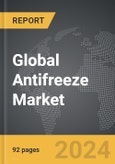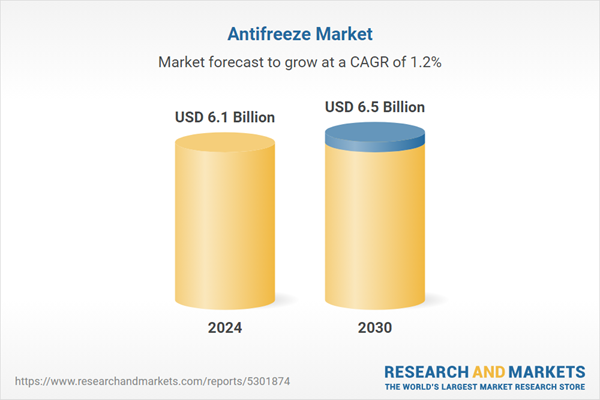Global Antifreeze Market - Key Trends and Drivers Summarized
Why Is Antifreeze Critical for Modern Engines and Vehicle Performance?
Antifreeze, often referred to as engine coolant, is an essential fluid for maintaining the optimal functioning of internal combustion engines. Its primary purpose is to regulate the temperature of the engine, preventing the coolant from freezing in cold weather and boiling during extreme heat. This temperature regulation is crucial for preventing engine components from overheating, which can cause significant damage. But why is antifreeze so vital in modern automotive applications? Composed primarily of ethylene glycol, propylene glycol, and water, antifreeze circulates through the engine's cooling system, transferring heat away from vital engine parts. This helps to maintain a stable operating temperature regardless of external conditions. Additionally, the fluid contains additives that provide protection against rust, corrosion, and mineral scale build-up within the radiator and other parts of the cooling system. These additives help extend the longevity of the engine and improve overall vehicle performance, particularly in more advanced engine designs that are highly sensitive to temperature fluctuations. Over the years, antifreeze formulations have been refined to meet the increasing demands of more powerful and efficient engines, making it indispensable in both everyday driving and extreme conditions.What Safety Issues Surround the Use of Antifreeze?
Despite its critical role in vehicle maintenance, antifreeze has long been associated with significant safety concerns, primarily due to its toxicity. The most common type of antifreeze, ethylene glycol, is highly toxic when ingested and poses a major risk to both humans and animals. Its sweet smell and taste make it particularly attractive to pets and small children, leading to accidental poisonings that can result in severe health consequences or even death. Over time, public health campaigns and regulatory efforts have raised awareness about these dangers, prompting manufacturers to develop safer alternatives. Propylene glycol, a less toxic form of antifreeze, has gained popularity as a safer option, reducing the risk of accidental ingestion. Additionally, bittering agents are now commonly added to antifreeze to deter accidental consumption by making it taste unpleasant. Despite these advancements, improper disposal and accidental spills of antifreeze continue to be an environmental and public health concern. Antifreeze that leaks from vehicles or is disposed of incorrectly can contaminate groundwater and harm local wildlife, emphasizing the need for strict disposal protocols and continued regulatory oversight. As these safety issues have become more widely recognized, both manufacturers and consumers are adopting safer handling, storage, and disposal practices to mitigate the risks associated with antifreeze.How Is Antifreeze Technology Adapting to Modern Automotive Needs?
The evolution of antifreeze technology has been driven by the rapid advancements in automotive engineering, requiring increasingly sophisticated solutions to meet the thermal management needs of modern vehicles. In particular, the shift towards high-performance, turbocharged engines has placed greater demands on the cooling systems of vehicles, necessitating more robust antifreeze formulations that can withstand extreme heat and pressure without breaking down. Modern antifreeze blends now feature long-life formulations designed to last longer, providing extended protection against corrosion, freezing, and overheating, thus reducing the frequency of coolant replacements. These advanced coolants are also formulated to cater to the specific needs of different types of vehicles and climates. For example, vehicles operating in cold climates may require antifreeze with a lower freezing point, while those in warmer regions need a higher boiling point. Furthermore, the rise of electric vehicles (EVs) has not diminished the importance of antifreeze. Although EVs do not have traditional combustion engines, they still require thermal management systems to regulate the temperature of their batteries and electronic components, which can overheat during extended use. Heavy-duty vehicles, such as trucks and construction machinery, have also driven innovation in antifreeze technology, with specialized variants now available to meet the rigorous demands of these applications. Additionally, the growing emphasis on environmental sustainability has prompted the development of biodegradable antifreeze solutions that reduce the ecological impact of coolant disposal, signaling a move towards greener, more eco-friendly alternatives.What Factors Are Driving the Growth of the Antifreeze Market?
The growth in the antifreeze market is driven by several factors, including the expanding global automotive fleet, technological advancements in engine design, and changing consumer preferences towards more durable and efficient coolants. One of the primary drivers is the continued growth of the automotive industry, particularly in emerging economies where vehicle ownership is rapidly increasing. As more cars, trucks, and commercial vehicles are produced and sold, the demand for antifreeze products grows in tandem. In addition, advancements in engine technology have led to the development of high-performance engines that operate at higher temperatures and require more advanced cooling systems. These engines, particularly those found in luxury and performance vehicles, necessitate antifreeze solutions capable of handling higher thermal loads, thus driving the demand for specialized, high-performance coolants. Another significant factor contributing to the market's growth is the increasing consumer preference for long-life antifreeze products. These products, which offer extended protection and reduced maintenance needs, appeal to consumers seeking to lower the overall cost of vehicle ownership while ensuring maximum engine protection. Furthermore, the growing adoption of electric and hybrid vehicles has expanded the scope of the antifreeze market, as these vehicles rely on effective thermal management systems to prevent overheating of their batteries and electrical components. Lastly, the increasing focus on environmental regulations has pushed manufacturers to innovate and develop eco-friendly antifreeze solutions that meet stringent environmental standards, further boosting market demand. As consumers and manufacturers alike prioritize sustainability, the market for biodegradable and less toxic antifreeze products is expected to grow, reflecting a broader shift towards environmentally responsible automotive technologies.Report Scope
The report analyzes the Antifreeze market, presented in terms of market value (US$ Thousand). The analysis covers the key segments and geographic regions outlined below.- Segments: Base Fluid (Ethylene Glycol, Propylene Glycol, Glycerine); Technology (OAT, HOAT, IAT); Application (Automotive, Industrial, Other Applications).
- Geographic Regions/Countries:World; United States; Canada; Japan; China; Europe (France; Germany; Italy; United Kingdom; and Rest of Europe); Asia-Pacific; Rest of World.
Key Insights:
- Market Growth: Understand the significant growth trajectory of the Ethylene Glycol Base Fluid segment, which is expected to reach US$3.5 Billion by 2030 with a CAGR of a 0.9%. The Propylene Glycol Base Fluid segment is also set to grow at 1.5% CAGR over the analysis period.
Why You Should Buy This Report:
- Detailed Market Analysis: Access a thorough analysis of the Global Antifreeze Market, covering all major geographic regions and market segments.
- Competitive Insights: Get an overview of the competitive landscape, including the market presence of major players across different geographies.
- Future Trends and Drivers: Understand the key trends and drivers shaping the future of the Global Antifreeze Market.
- Actionable Insights: Benefit from actionable insights that can help you identify new revenue opportunities and make strategic business decisions.
Key Questions Answered:
- How is the Global Antifreeze Market expected to evolve by 2030?
- What are the main drivers and restraints affecting the market?
- Which market segments will grow the most over the forecast period?
- How will market shares for different regions and segments change by 2030?
- Who are the leading players in the market, and what are their prospects?
Report Features:
- Comprehensive Market Data: Independent analysis of annual sales and market forecasts in US$ Million from 2024 to 2030.
- In-Depth Regional Analysis: Detailed insights into key markets, including the U.S., China, Japan, Canada, Europe, Asia-Pacific, Latin America, Middle East, and Africa.
- Company Profiles: Coverage of players such as Amsoil, BASF SE, BP PLC, CCI Corporation, Chevron Corporation and more.
- Complimentary Updates: Receive free report updates for one year to keep you informed of the latest market developments.
Some of the 36 companies featured in this Antifreeze market report include:
- Amsoil
- BASF SE
- BP PLC
- CCI Corporation
- Chevron Corporation
- Gulf Oil International
- KMCO
- KOST USA, Inc.
- Millers Oils
- MITAN
- Old World Industries Inc
- PARAS Lubricants
- PENTOSIN
- Recochem Inc.
- Royal Dutch Shell PLC
- SONAX GmbH
- Total
This edition integrates the latest global trade and economic shifts into comprehensive market analysis. Key updates include:
- Tariff and Trade Impact: Insights into global tariff negotiations across 180+ countries, with analysis of supply chain turbulence, sourcing disruptions, and geographic realignment. Special focus on 2025 as a pivotal year for trade tensions, including updated perspectives on the Trump-era tariffs.
- Adjusted Forecasts and Analytics: Revised global and regional market forecasts through 2030, incorporating tariff effects, economic uncertainty, and structural changes in globalization. Includes historical analysis from 2015 to 2023.
- Strategic Market Dynamics: Evaluation of revised market prospects, regional outlooks, and key economic indicators such as population and urbanization trends.
- Innovation & Technology Trends: Latest developments in product and process innovation, emerging technologies, and key industry drivers shaping the competitive landscape.
- Competitive Intelligence: Updated global market share estimates for 2025, competitive positioning of major players (Strong/Active/Niche/Trivial), and refined focus on leading global brands and core players.
- Expert Insight & Commentary: Strategic analysis from economists, trade experts, and domain specialists to contextualize market shifts and identify emerging opportunities.
Table of Contents
Companies Mentioned (Partial List)
A selection of companies mentioned in this report includes, but is not limited to:
- Amsoil
- BASF SE
- BP PLC
- CCI Corporation
- Chevron Corporation
- Gulf Oil International
- KMCO
- KOST USA, Inc.
- Millers Oils
- MITAN
- Old World Industries Inc
- PARAS Lubricants
- PENTOSIN
- Recochem Inc.
- Royal Dutch Shell PLC
- SONAX GmbH
- Total
Table Information
| Report Attribute | Details |
|---|---|
| No. of Pages | 219 |
| Published | December 2025 |
| Forecast Period | 2024 - 2030 |
| Estimated Market Value ( USD | $ 6.1 Billion |
| Forecasted Market Value ( USD | $ 6.5 Billion |
| Compound Annual Growth Rate | 1.2% |
| Regions Covered | Global |









